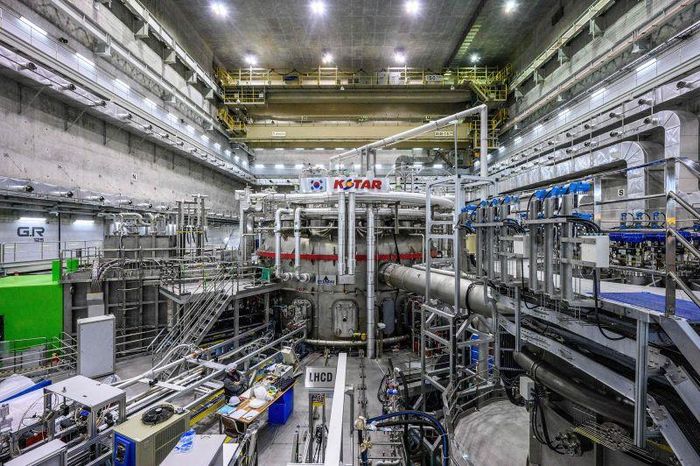How do electric car batteries work?
In principle, the battery in an electric vehicle will conduct energy to the controller that runs the electric motor or the car's engines. As for the structure of the battery, it is about a device that stores energy and converts it into electricity when needed.
Inside, the battery is made up of electrochemical cell blocks and each block is further divided into 2 parts called electrodes. One is the negative electrode and it contains negatively charged subatomic particles called electrons, the other is the positive electrode, which contains no electrons at all.
When the positive and negative electrodes are connected together, the negative electrodes will flow towards the positive and this flow is called electricity.

The resulting energy will be used to run the electric motor in your electric vehicle. As the electrons continue to move, they eventually slow down and the voltage produced by the battery drops. When the current drops to the point where there are as many positive electrons on the positive side as on the negative side, the battery no longer produces current.
So electric vehicle batteries are designed to be rechargeable, and by plugging them into your car, the electrical energy is used to reverse the negative and positive halves of the cell, thus restarting the energy storage process of battery.
There are currently three different types of batteries used in electric cars: Lead-acid batteries, Nickel metal hydride (NiMH) batteries and lithium-ion batteries.
1. Lead Acid Battery
This is the oldest battery technology and is largely defunct. They are quite similar to regular car batteries and are used to power cargo vans and golf carts. Some early electric vehicles also used this type of battery, such as the General Motors EV1 using a 16.5-18.7 kWh lead-acid battery for a range of 88.5 km.
As an early technology, these batteries were not perfect because they were heavy, had low power, performed poorly in cold weather, and had to be replaced every few years. So this is definitely not an ideal battery.
2. Nickel metal hydride battery
Nickel metal hydride (NiMH) batteries are used in many hybrid vehicles and early popular electric vehicles such as the Nissan Leaf. The big advantage of NiMH batteries over lead acid batteries is their long life and significantly higher specific energy, meaning a battery of equivalent weight can provide more power and if properly cared for and charged, This type of battery can last longer than lead acid batteries.
However, NiMH batteries also do not perform well in cold climates. Their price is also quite high and this type of battery discharges energy very quickly when not in use. Overall, this battery is not very efficient and must be treated very carefully to avoid long-term damage.
3. Lithium-ion battery
The current gold standard in battery technology is Lithium-ion. This technology was initially developed for laptops and mobile phones. They typically have a long lifespan and high energy density.
Original Li-ion batteries are sensitive to temperature and pose a risk of fire and explosion if charged improperly. However, these batteries have been thoroughly developed with new chemistries that make them more stable, more powerful and easier to recharge. Because Li-ion batteries are sensitive to heat, they need to be preheated to the correct operating range to effectively maintain charge and maintain battery life. That's why the preheat function is included in many electric vehicles.
Each type of battery has certain advantages and disadvantages. Lithium-ion is suitable for low-cost vehicles and has a longer life, shorter operating range, fast charging performance and greater operating range.
Experts predict that in the next few years, batteries for electric vehicles will be significantly improved, improving performance and longevity. Importantly, battery manufacturers and car manufacturers have now equipped measures to ensure safety, durability and maintain good battery life.
You should read it
- This technology can help fully charge an electric car's battery in just 10 minutes
- Samsung's new battery technology can allow electric cars to run up to 800km on a single charge
- How does cold weather affect electric car batteries?
- This portable electric chair can reach speeds of 40km / h
- How are old electric car batteries recycled?
- Great idea about a robot that can find and charge electric vehicles on its own
- Electric eel - inspired to create biocompatible hydrogel batteries
- What is a Graphene battery and how can it change the world of technology?
- New materials for lithium-ion batteries can double the distance for electric vehicles
- Teddy bears also fool the self-driving system of electric cars
- Tesla's 'Roadrunner' secret project reveals: Mass production of large-capacity batteries for $ 100 per kWh
- How to Use an Electric Car
May be interested

Do you know how to use the Internet safely?

China: The capital Beijing builds a robot industrial park

South Korea achieved a new breakthrough with nuclear fusion experiments

How to delete multiple Instagram Reels videos at once with a few simple steps

Cheap iPhone reveals new design

Billionaire Elon Musk is turning his attention to Cardano?






 How are old electric car batteries recycled?
How are old electric car batteries recycled? Samsung's new battery technology can allow electric cars to run up to 800km on a single charge
Samsung's new battery technology can allow electric cars to run up to 800km on a single charge Electric eel - inspired to create biocompatible hydrogel batteries
Electric eel - inspired to create biocompatible hydrogel batteries Successfully manufactured smartphone batteries that work well in conditions of -70 ° C
Successfully manufactured smartphone batteries that work well in conditions of -70 ° C New materials for lithium-ion batteries can double the distance for electric vehicles
New materials for lithium-ion batteries can double the distance for electric vehicles This technology can help fully charge an electric car's battery in just 10 minutes
This technology can help fully charge an electric car's battery in just 10 minutes